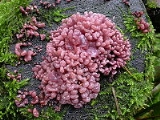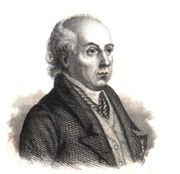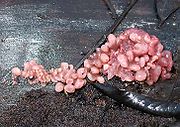
Ascocoryne sarcoides
Encyclopedia
Ascocoryne sarcoides is a species of fungus
in the Helotiaceae
family. Formerly known as Coryne sarcoides, its taxonomical
history has been complicated by the fact that it may adopt both sexual and asexual forms. Colloquially known as jelly drops or the purple jellydisc, this common fungus appears as a gelatinous mass of pinkish or purple-colored discs. Distributed widely in North America, Europe and Asia, A. sarcoides is a saprobic fungus and grows in clusters on the trunks and branches of a variety of dead woods. Field studies suggest that colonization by A. sarcoides of the heartwood of black spruce
confers some resistance to further infection by rot-causing fungi
. A. sarcoides contains the antibiotic
compound ascocorynin, shown in the laboratory to inhibit the growth of several Gram-positive
bacteria.
 The taxonomical
The taxonomical
history of this fungus has been complicated by the fact that its life cycle
allows for both an imperfect (making asexual spores, or conidia) or perfect (making sexual spores) form; at various times authors have assigned names to one or the other form, but these names have often been at odds with the accepted rules of fungal nomenclature. It was originally described in 1781 by the Dutch scientist Nikolaus Joseph von Jacquin
as Lichen sarcoides. Christian Hendrik Persoon
called it Peziza sarcoides in 1801. Elias Magnus Fries
, in his 1822 publication Systema Mycologicum, described the imperfect state of the fungus under the name Tremella sarcoides. The genus name Coryne was first used in 1851 by Bonorden, who proposed Coryne sarcoides for the imperfect state; in 1865 the Tulasne brothers (Charles
and Louis René
) used Coryne to refer to both the perfect and imperfect forms. It was designated the type species
for the genus in a 1931 publication by Clements and Shear.
Several decades later it became apparent that the name Coryne sarcoides violated the naming conventions imposed by fungal taxonomists—specifically, the species was named after the imperfect state, so in 1967, Groves and Wilson proposed the new genus name Ascocoryne to accommodate the perfect state. The conidial state of this fungus is Coryne dubia Persoon ex S. F. Gray (synonymous with Pirobasidium sarcoides von Hoehnel). The specific epithet is derived from Greek
and means "fleshy, flesh-like", from σάρξ (sarx, sarc- in compounds), "flesh", and the common adjectival ending -οειδής (-oeides), "similar, -like".
), or have a rudimentary stem. The apothecia are accompanied by a conidial
form, where non-sexual spores are generated. The conidial form consists of sporodochia, a cushion-like asexual fruiting body mass consisting of short conidiophores (specialized stalks that bear conidia). The sporodochia are similar in color and consistency to the apothecia but very variable in shape, typically club-, spoon-, or tongue-shaped, and bearing minute, cylindrical, straight or curved conidia. As the fungus matures and the apothecia enlarge and press against each other, the apothecia coalesce to form a gelatinous, irregular mass. The flesh
, similar to the appearance of the fungus, is pinkish-purple and gelatinous. The odor and taste of A. sarcoides are not distinctive.
), smooth, have an ellipsoid shape, with dimensions of 12–16 by 3–5 µm
. Spores contain one or two oil droplets. The imperfect (conidial) form of the fungus produces smooth, hyaline spores that are 3–3.5 by 1–2 µm. The asci
– sexual spore-bearing cells – have a cylindrical shape, with dimensions of 115–125 by 8–10 µm. The paraphyses
(sterile filamentous cells interspersed among the asci) are cylindrical with slightly swollen tips, and few branches.
, and as such is usually found growing on the stumps and logs of fallen deciduous
trees. However, it is also found on a variety of living trees as well. For example, in Europe it has been found on the stems of living spruce (Picea abies) in Finland, France, Great Britain, Norway, and Germany.
Other collections sites include Australia, China, Cuba, Iceland, Korea, and Taiwan. In Hawaii
, it grows on trunks of fallen Cibotium
and Aleurites
trees. A. sarcoides occurs most frequently in late summer and autumn.
 A number of field studies conducted in the boreal forest
A number of field studies conducted in the boreal forest
region of Northern Ontario
(Canada) showed that A. sarcoides was found to be frequently associated with various deciduous
and coniferous tree hosts that had been affected by the fungal disease known as heart rot
; this discovery was noted as unusual, as most fungal tree infections are known to be caused by Basidiomycetes, not Ascomycetes. In the case of the commercially valuable tree species black spruce (Picea mariana), it was determined that prior colonization by A. sarcoides reduces the incidence of subsequent infection by common fungal pathogens, such as Fomes pini and Scytinostroma galactina; furthermore, A. sarcoides can exist in the wood with no noticeable harmful effects on the host. A similar relationship was shown later to exist with jack pine trees (species Pinus banksiana), whereby A. sarcoides inhibited Peniophora pseudopini, but had little effect on the subsequent growth of Fomes pini. The study also showed that A. sarcoides is isolated more frequently from defective wood as the age of the tree increases (trees examined in the study were over 80 years old), and that it can infect both uninfected heartwood as well as previously decayed wood; in the latter case it usually coexists with the causal fungi.
 Terphenylquinones are chemical compounds that are widely distributed among the Basidiomycetes division of fungi. Ascocoryne sarcoides has been shown to contain a terphenylquinone named ascocorynin—a chemical derivative
Terphenylquinones are chemical compounds that are widely distributed among the Basidiomycetes division of fungi. Ascocoryne sarcoides has been shown to contain a terphenylquinone named ascocorynin—a chemical derivative
of the compound benzoquinone. This pigment
, when in alkaline solution, turns a dark violet
, similar in color to the fruit bodies of the fungus. Ascocorynin has moderate antibiotic
activity, and was shown in laboratory tests to inhibit the growth of several Gram-positive
bacteria, including the widely distributed food spoilage organism Bacillus stearothermophilus
; however, it has no effect on the growth on Gram-negative
bacteria, nor does it have any anti-fungal activity.
. T. foliacea is larger, brown, and leafy in appearance. Auricularia auricula is also larger, typically brown, is disc- or ear-shaped, with a ribbed undersurface. Microscopically, Tremella foliacea and Auricularia auricula are easily distinguished from A. sarcoides by the presence of basidia (rather than asci).
Fungus
A fungus is a member of a large group of eukaryotic organisms that includes microorganisms such as yeasts and molds , as well as the more familiar mushrooms. These organisms are classified as a kingdom, Fungi, which is separate from plants, animals, and bacteria...
in the Helotiaceae
Helotiaceae
The Helotiaceae are a family of fungi in the Helotiales order. The distribution of species in the family are widespread, and typically found in tropical areas...
family. Formerly known as Coryne sarcoides, its taxonomical
Taxonomy
Taxonomy is the science of identifying and naming species, and arranging them into a classification. The field of taxonomy, sometimes referred to as "biological taxonomy", revolves around the description and use of taxonomic units, known as taxa...
history has been complicated by the fact that it may adopt both sexual and asexual forms. Colloquially known as jelly drops or the purple jellydisc, this common fungus appears as a gelatinous mass of pinkish or purple-colored discs. Distributed widely in North America, Europe and Asia, A. sarcoides is a saprobic fungus and grows in clusters on the trunks and branches of a variety of dead woods. Field studies suggest that colonization by A. sarcoides of the heartwood of black spruce
Black Spruce
Picea mariana is a species of spruce native to northern North America, from Newfoundland west to Alaska, and south to northern New York, Minnesota and central British Columbia...
confers some resistance to further infection by rot-causing fungi
Wood-decay fungus
A wood-decay fungus is a variety of fungus that digests moist wood, causing it to rot. Some wood-decay fungi attack dead wood, such as brown rot, and some, such as Armillaria , are parasitic and colonize living trees. Fungi that not only grow on wood but actually cause it to decay, are called...
. A. sarcoides contains the antibiotic
Antibiotic
An antibacterial is a compound or substance that kills or slows down the growth of bacteria.The term is often used synonymously with the term antibiotic; today, however, with increased knowledge of the causative agents of various infectious diseases, antibiotic has come to denote a broader range of...
compound ascocorynin, shown in the laboratory to inhibit the growth of several Gram-positive
Gram-positive
Gram-positive bacteria are those that are stained dark blue or violet by Gram staining. This is in contrast to Gram-negative bacteria, which cannot retain the crystal violet stain, instead taking up the counterstain and appearing red or pink...
bacteria.
Taxonomy

Taxonomy
Taxonomy is the science of identifying and naming species, and arranging them into a classification. The field of taxonomy, sometimes referred to as "biological taxonomy", revolves around the description and use of taxonomic units, known as taxa...
history of this fungus has been complicated by the fact that its life cycle
Biological life cycle
A life cycle is a period involving all different generations of a species succeeding each other through means of reproduction, whether through asexual reproduction or sexual reproduction...
allows for both an imperfect (making asexual spores, or conidia) or perfect (making sexual spores) form; at various times authors have assigned names to one or the other form, but these names have often been at odds with the accepted rules of fungal nomenclature. It was originally described in 1781 by the Dutch scientist Nikolaus Joseph von Jacquin
Nikolaus Joseph von Jacquin
Nikolaus Joseph Freiherr von Jacquin or Baron Nikolaus von Jacquin. was a scientist who studied medicine, chemistry and botany....
as Lichen sarcoides. Christian Hendrik Persoon
Christian Hendrik Persoon
Christiaan Hendrik Persoon was a mycologist who made additions to Linnaeus' mushroom taxonomy.-Early life:...
called it Peziza sarcoides in 1801. Elias Magnus Fries
Elias Magnus Fries
-External links:*, Authors of fungal names, Mushroom, the Journal of Wild Mushrooming.*...
, in his 1822 publication Systema Mycologicum, described the imperfect state of the fungus under the name Tremella sarcoides. The genus name Coryne was first used in 1851 by Bonorden, who proposed Coryne sarcoides for the imperfect state; in 1865 the Tulasne brothers (Charles
Charles Tulasne
Charles Tulasne was a French physician and mycologist who was born in Langeais in the département of Indre-et-Loire. He received his medical doctorate in 1840 and practiced medicine in Paris until 1854. Afterwards he worked with his older brother Louis René Tulasne in the field of mycology...
and Louis René
Louis René Tulasne
Louis René Tulasne, aka Edmond Tulasne was a French botanist and mycologist who was born in Azay-le-Rideau. He originally studied law at Poitiers, but his interest later turned to botany. As a young man he accompanied botanist Auguste de Saint-Hilaire to South America to study the flora of Brazil...
) used Coryne to refer to both the perfect and imperfect forms. It was designated the type species
Type species
In biological nomenclature, a type species is both a concept and a practical system which is used in the classification and nomenclature of animals and plants. The value of a "type species" lies in the fact that it makes clear what is meant by a particular genus name. A type species is the species...
for the genus in a 1931 publication by Clements and Shear.
Several decades later it became apparent that the name Coryne sarcoides violated the naming conventions imposed by fungal taxonomists—specifically, the species was named after the imperfect state, so in 1967, Groves and Wilson proposed the new genus name Ascocoryne to accommodate the perfect state. The conidial state of this fungus is Coryne dubia Persoon ex S. F. Gray (synonymous with Pirobasidium sarcoides von Hoehnel). The specific epithet is derived from Greek
Greek language
Greek is an independent branch of the Indo-European family of languages. Native to the southern Balkans, it has the longest documented history of any Indo-European language, spanning 34 centuries of written records. Its writing system has been the Greek alphabet for the majority of its history;...
and means "fleshy, flesh-like", from σάρξ (sarx, sarc- in compounds), "flesh", and the common adjectival ending -οειδής (-oeides), "similar, -like".
Description
This fungus is characterized by a fruiting body (technically an apothecia) with a pinkish-purple color and more or less gelatinous consistency. The apothecia, typically 0.5 to 1.5 cm (0.196850393700787 to 0.590551181102362 in) in diameter, start with a roughly spherical shape, then eventually flatten out to become shallowly cup-shaped with a wavy edge and smooth upper surface. The lower surface may be covered with small particles (granular), and the apothecia are either attached directly to the growing surface (sessileSessility (botany)
In botany, sessility is a characteristic of plants whose flowers or leaves are borne directly from the stem or peduncle, and thus lack a petiole or pedicel...
), or have a rudimentary stem. The apothecia are accompanied by a conidial
Conidium
Conidia, sometimes termed conidiospores, are asexual, non-motile spores of a fungus and are named after the greek word for dust, konia. They are also called mitospores due to the way they are generated through the cellular process of mitosis...
form, where non-sexual spores are generated. The conidial form consists of sporodochia, a cushion-like asexual fruiting body mass consisting of short conidiophores (specialized stalks that bear conidia). The sporodochia are similar in color and consistency to the apothecia but very variable in shape, typically club-, spoon-, or tongue-shaped, and bearing minute, cylindrical, straight or curved conidia. As the fungus matures and the apothecia enlarge and press against each other, the apothecia coalesce to form a gelatinous, irregular mass. The flesh
Trama (mycology)
In mycology trama is a term for the inner, fleshy portion of a mushroom's basidiocarp, or fruit body. It is distinct from the outer layer of tissue, known as the pileipellis or cuticle, and from the spore-bearing tissue layer known as the hymenium....
, similar to the appearance of the fungus, is pinkish-purple and gelatinous. The odor and taste of A. sarcoides are not distinctive.
Microscopic features
The spores are translucent (hyalineHyaline
The term hyaline denotes a substance with a glass-like appearance.-Histopathology:In histopathological medical usage, a hyaline substance appears glassy and pink after being stained with haematoxylin and eosin — usually it is an acellular, proteinaceous material...
), smooth, have an ellipsoid shape, with dimensions of 12–16 by 3–5 µm
Micrometre
A micrometer , is by definition 1×10-6 of a meter .In plain English, it means one-millionth of a meter . Its unit symbol in the International System of Units is μm...
. Spores contain one or two oil droplets. The imperfect (conidial) form of the fungus produces smooth, hyaline spores that are 3–3.5 by 1–2 µm. The asci
Ascus
An ascus is the sexual spore-bearing cell produced in ascomycete fungi. On average, asci normally contain eight ascospores, produced by a meiotic cell division followed, in most species, by a mitotic cell division. However, asci in some genera or species can number one , two, four, or multiples...
– sexual spore-bearing cells – have a cylindrical shape, with dimensions of 115–125 by 8–10 µm. The paraphyses
Paraphyses
Paraphyses are part of the fertile spore-bearing layer in certain fungi. More specifically, paraphyses are sterile filamentous hyphal end cells composing part of the hymenium of Ascomycota and Basidiomycota interspersed among either the asci or basidia respectively, and not sufficiently...
(sterile filamentous cells interspersed among the asci) are cylindrical with slightly swollen tips, and few branches.
Habitat and distribution
This species has a broad distribution in forested areas of North America and Europe. A saprobic fungus, it derives nutrients from decaying organic matterOrganic matter
Organic matter is matter that has come from a once-living organism; is capable of decay, or the product of decay; or is composed of organic compounds...
, and as such is usually found growing on the stumps and logs of fallen deciduous
Deciduous
Deciduous means "falling off at maturity" or "tending to fall off", and is typically used in reference to trees or shrubs that lose their leaves seasonally, and to the shedding of other plant structures such as petals after flowering or fruit when ripe...
trees. However, it is also found on a variety of living trees as well. For example, in Europe it has been found on the stems of living spruce (Picea abies) in Finland, France, Great Britain, Norway, and Germany.
Other collections sites include Australia, China, Cuba, Iceland, Korea, and Taiwan. In Hawaii
Hawaii
Hawaii is the newest of the 50 U.S. states , and is the only U.S. state made up entirely of islands. It is the northernmost island group in Polynesia, occupying most of an archipelago in the central Pacific Ocean, southwest of the continental United States, southeast of Japan, and northeast of...
, it grows on trunks of fallen Cibotium
Cibotium
Cibotium is a genus of eleven species of tropical tree fern—subject to much confusion and revision—distributed fairly narrowly in Hawaii , Southeast Asia , and the cloud forests of Central America and Mexico...
and Aleurites
Aleurites
Aleurites is a small arborescent genus of flowering plants in the tropical and subtropical regions of Asia, the Pacific and South America, belonging to the spurge family Euphorbiaceae.These monoecious, evergreen trees are perennials or semi-perennials...
trees. A. sarcoides occurs most frequently in late summer and autumn.
Role in tree decay

Boreal forest of Canada
Canada's boreal forest comprises about one third of the circumpolar boreal forest that rings the northern hemisphere, mostly north of the 50th parallel. Other countries with boreal forest include Russia, which contains the majority, and the Scandinavian and Nordic countries . The boreal region in...
region of Northern Ontario
Northern Ontario
Northern Ontario is a region of the Canadian province of Ontario which lies north of Lake Huron , the French River and Lake Nipissing. The region has a land area of 802,000 km2 and constitutes 87% of the land area of Ontario, although it contains only about 6% of the population...
(Canada) showed that A. sarcoides was found to be frequently associated with various deciduous
Deciduous
Deciduous means "falling off at maturity" or "tending to fall off", and is typically used in reference to trees or shrubs that lose their leaves seasonally, and to the shedding of other plant structures such as petals after flowering or fruit when ripe...
and coniferous tree hosts that had been affected by the fungal disease known as heart rot
Heart rot
thumb|300px|right|The bracket fungus [[Fistulina hepatica]] is one of many that cause heart rot.In trees, heart rot is a fungal disease that causes the decay of wood at the center of the trunk and branches. Fungi enter the tree through wounds in the bark and decay the heartwood. The diseased...
; this discovery was noted as unusual, as most fungal tree infections are known to be caused by Basidiomycetes, not Ascomycetes. In the case of the commercially valuable tree species black spruce (Picea mariana), it was determined that prior colonization by A. sarcoides reduces the incidence of subsequent infection by common fungal pathogens, such as Fomes pini and Scytinostroma galactina; furthermore, A. sarcoides can exist in the wood with no noticeable harmful effects on the host. A similar relationship was shown later to exist with jack pine trees (species Pinus banksiana), whereby A. sarcoides inhibited Peniophora pseudopini, but had little effect on the subsequent growth of Fomes pini. The study also showed that A. sarcoides is isolated more frequently from defective wood as the age of the tree increases (trees examined in the study were over 80 years old), and that it can infect both uninfected heartwood as well as previously decayed wood; in the latter case it usually coexists with the causal fungi.
Bioactive compounds

Derivative (chemistry)
In chemistry, a derivative is a compound that is derived from a similar compound by some chemical or physical process. In the past it was also used to mean a compound that can be imagined to arise from another compound, if one atom is replaced with another atom or group of atoms, but modern...
of the compound benzoquinone. This pigment
Pigment
A pigment is a material that changes the color of reflected or transmitted light as the result of wavelength-selective absorption. This physical process differs from fluorescence, phosphorescence, and other forms of luminescence, in which a material emits light.Many materials selectively absorb...
, when in alkaline solution, turns a dark violet
Violet (color)
As the name of a color, violet is synonymous with a bluish purple, when the word "purple" is used in the common English language sense of any color between blue and red, not including either blue or red...
, similar in color to the fruit bodies of the fungus. Ascocorynin has moderate antibiotic
Antibiotic
An antibacterial is a compound or substance that kills or slows down the growth of bacteria.The term is often used synonymously with the term antibiotic; today, however, with increased knowledge of the causative agents of various infectious diseases, antibiotic has come to denote a broader range of...
activity, and was shown in laboratory tests to inhibit the growth of several Gram-positive
Gram-positive
Gram-positive bacteria are those that are stained dark blue or violet by Gram staining. This is in contrast to Gram-negative bacteria, which cannot retain the crystal violet stain, instead taking up the counterstain and appearing red or pink...
bacteria, including the widely distributed food spoilage organism Bacillus stearothermophilus
Bacillus stearothermophilus
Bacillus stearothermophilus is a rod-shaped, Gram-positive bacterium and a member of the division Firmicutes. The bacteria is a thermophile and is widely distributed in soil, hot springs, ocean sediment, and is a cause of spoilage in food products. It will grow within a temperature range of 30-75...
; however, it has no effect on the growth on Gram-negative
Gram-negative
Gram-negative bacteria are bacteria that do not retain crystal violet dye in the Gram staining protocol. In a Gram stain test, a counterstain is added after the crystal violet, coloring all Gram-negative bacteria with a red or pink color...
bacteria, nor does it have any anti-fungal activity.
Similar species
Ascocoryne cylichnium, another small and gelatinous violet-colored species, has apothecia that are more often cup-shaped, and has larger spores—20–24 by 5.5–6 µm. Because of its resemblance to the jelly fungi, A. sarcoides has been mistaken for the basidiomycete species Auricularia auricula and Tremella foliaceaTremella foliacea
Tremella foliacea is a species of fungus producing brownish, frondose, gelatinous basidiocarps . It is widespread, particularly in north temperate regions, and is parasitic on other species of fungi , that grow on dead attached and recently fallen branches of broadleaf trees and conifers...
. T. foliacea is larger, brown, and leafy in appearance. Auricularia auricula is also larger, typically brown, is disc- or ear-shaped, with a ribbed undersurface. Microscopically, Tremella foliacea and Auricularia auricula are easily distinguished from A. sarcoides by the presence of basidia (rather than asci).
External links
- A. coryne at Index FungorumIndex FungorumIndex Fungorum, an international project to index all formal names in the Fungi Kingdom. Somewhat comparable to the IPNI, but with more contributing institutions....
- Ascocoryne images

